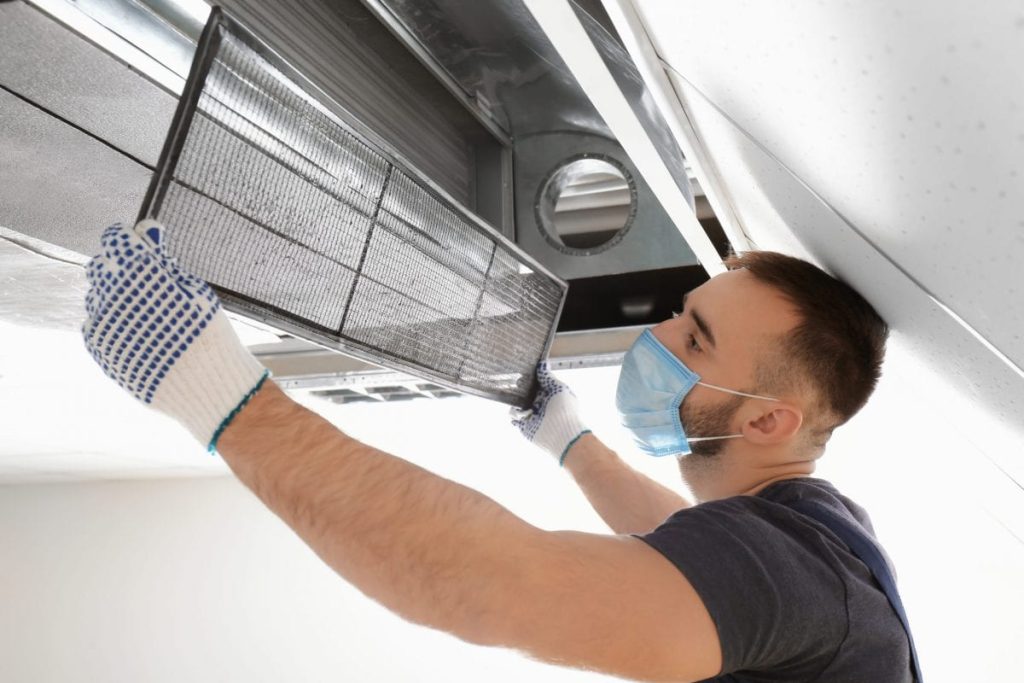Air duct cleaning is crucial for enhancing indoor air quality by eliminating dust, allergens, and contaminants from HVAC systems. Signs such as excess dust and musty odors indicate the need for cleaning. Through inspection, ductwork cleaning, and system sanitization, regular maintenance promotes better health and overall comfort in your living space.
In this article, we’ll discuss the importance of air duct cleaning, how to tell if your system needs to be cleaned, a step-by-step guide on how to do it yourself, and some additional measures you can take to enhance indoor air quality.
The Importance of Air Duct Cleaning
The importance of air duct cleaning cannot be overstated when it comes to maintaining a healthy indoor environment. Over time, air ducts accumulate dust, dirt, pet dander, pollen, mold spores, and other contaminants that circulate throughout your home. These pollutants can trigger allergies, and respiratory issues, and worsen existing health conditions.
By regularly cleaning your air ducts, you remove these harmful substances, improving the quality of the air you breathe. Clean air ducts also enhance the efficiency of your HVAC system, leading to energy savings and extending the lifespan of your equipment.
Signs that Indicate the Need for Air Duct Cleaning
Indoor air quality is crucial for maintaining a healthy living space.To ensure optimal indoor air quality, it’s important to be aware of the signs that indicate the need for air duct cleaning. Look out for the following indicators that it may be time to clean your air ducts:
Excessive Dust: If you constantly find a layer of dust settling on surfaces even after regular cleaning, it may indicate that your air ducts are circulating dusty air throughout your home.
Allergies and Respiratory Issues: Increased occurrences of allergies, asthma attacks, or respiratory discomfort among occupants could be a sign of contaminated air ducts, and spreading allergens and irritants.
Musty Odors: Unpleasant, musty smells coming from your vents suggest the presence of mold or mildew in the air ducts, which requires immediate attention and cleaning.
Reduced Air Flow: If you notice weak or inconsistent airflow from your vents, it could be due to blockages or obstructions in the air ducts, impeding proper air circulation.
Vermin Infestation: Signs of pests or rodents in your air ducts, such as droppings or nesting materials, indicate the need for cleaning to eliminate potential health hazards.
Step-by-Step Guide to Air Duct Cleaning
Regular air duct cleaning is essential for maintaining optimal indoor air quality and the efficiency of your HVAC system. Here is a step-by-step guide to air duct cleaning:
- Inspection– A professional technician will assess your HVAC system and air ducts to identify any issues, such as blockages, leaks, or signs of mold or pests.
- Preparation– The technician will protect your home by covering furniture, floors, and vents. They will also shut off the HVAC system to prevent the circulation of contaminants during the cleaning process.
- Cleaning Tools- Specialized tools, such as brushes, air whips, and high-powered vacuums, are used to dislodge and remove debris from the ducts.
- Duct Cleaning- The technician will clean each duct individually, starting from the main trunk lines and working their way towards the registers.
- Component Cleaning– In addition to the ducts, other HVAC components like the coils, blower fan, and grilles may also be cleaned to remove built-up dirt and improve system performance.
- Sanitization– To eliminate any remaining contaminants and inhibit microbial growth, a disinfectant or antimicrobial agent may be applied inside the air ducts.
- Final Checks– The technician will inspect the system once again to ensure all areas have been thoroughly cleaned. They will also check for any leaks or damages that may require repairs.
- System Restart– After completing the cleaning process, the HVAC system will be turned back on, and the technician will verify proper airflow and functioning.
Additional Measures to Enhance Indoor Air Quality
In addition to air duct cleaning, there are several additional measures you can take to further enhance indoor air quality. First, regularly replace or clean air filters in your HVAC system to trap dust and particles. Maintain proper ventilation by opening windows when weather permits or using exhaust fans in kitchens and bathrooms. Keep your home clean by dusting and vacuuming regularly, using microfiber cloths to capture dust effectively.
Minimize the use of harsh chemical cleaning products and opt for natural alternatives. Add indoor plants known for their air-purifying properties, such as peace lilies or spider plants. Finally, monitor and control humidity levels with a dehumidifier or humidifier to prevent mold growth.
Benefits of Regular Air Duct Cleaning for Health and Comfort
Regular air duct cleaning offers numerous benefits for both health and comfort and engaging the services of a professional like Ultimate Air Duct Cleaning can maximize these advantages. Check out the following benefits:
Improved Indoor Air Quality: Regular cleaning removes accumulated dust, allergens, and contaminants, ensuring cleaner and healthier air for breathing.
Allergy and Asthma Relief: By eliminating allergens from air ducts, such as pollen and pet dander, regular cleaning helps reduce allergy and asthma symptoms.
Odor Elimination: Cleaning removes unpleasant odors caused by mold, mildew, or accumulated debris, leaving your home smelling fresh and clean.
Extended HVAC System Lifespan: Regular cleaning reduces strain on your HVAC system, helping to prevent breakdowns and extend its longevity.
In conclusion
Air duct cleaning is an essential part of maintaining a healthy indoor environment. Through regular maintenance, it eliminates dust, allergens, and other contaminants from HVAC systems to improve the quality of the air you breathe.
By following our step-by-step guide and taking additional measures to enhance indoor air quality, you can enjoy improved health and comfort in your home. Invest in regular air duct cleaning for the health and well-being of you and your family.
